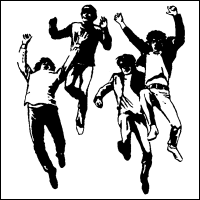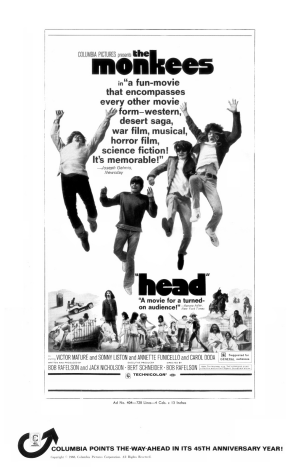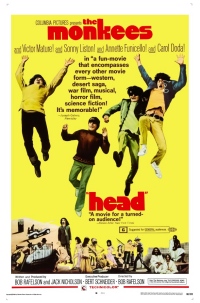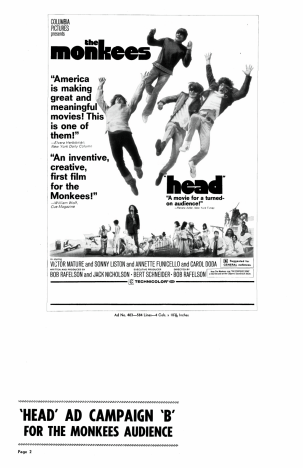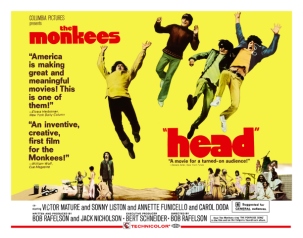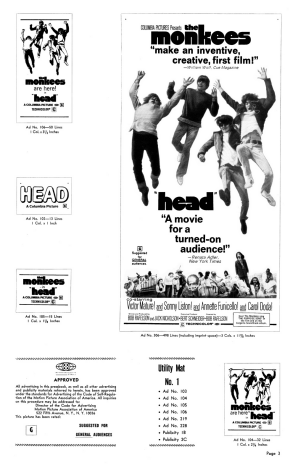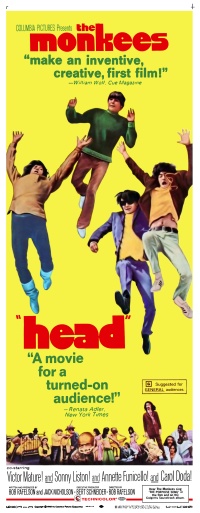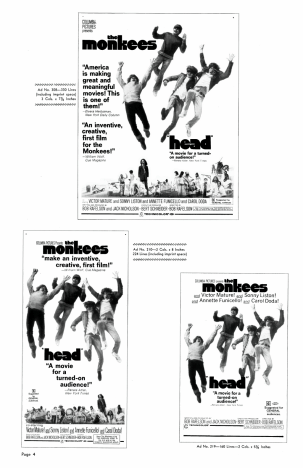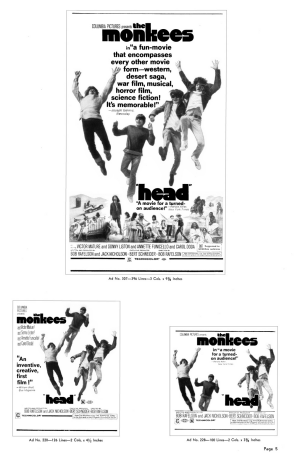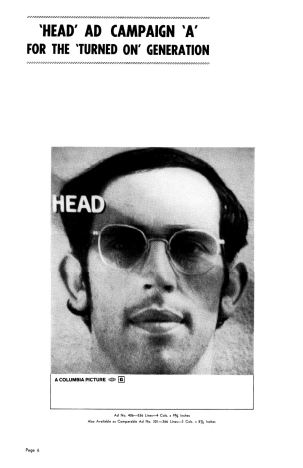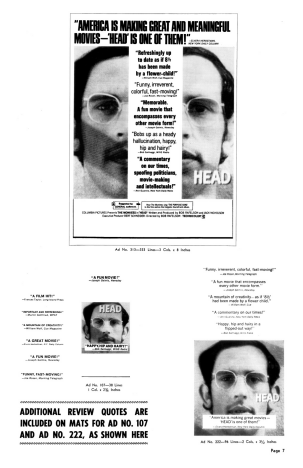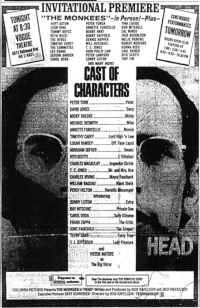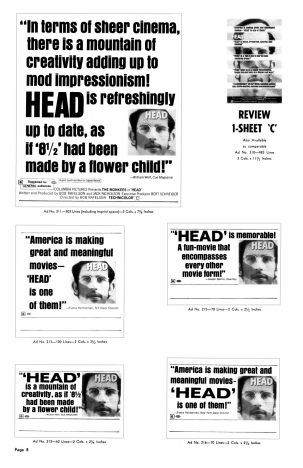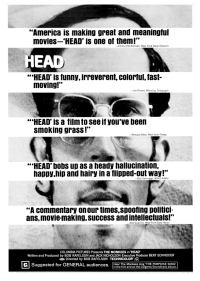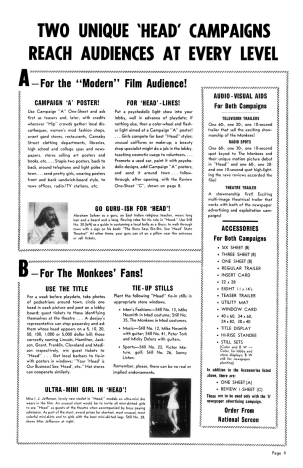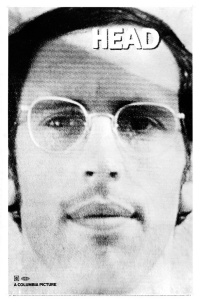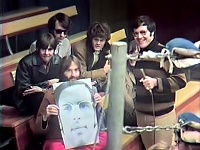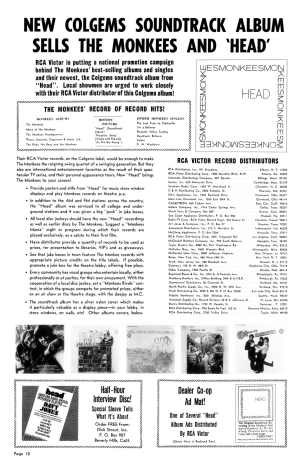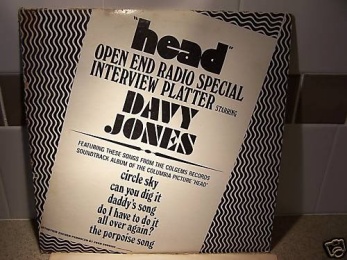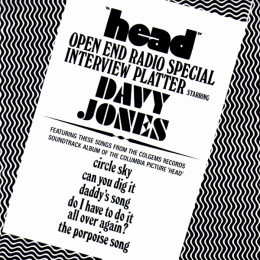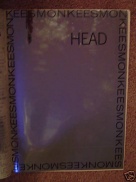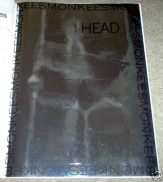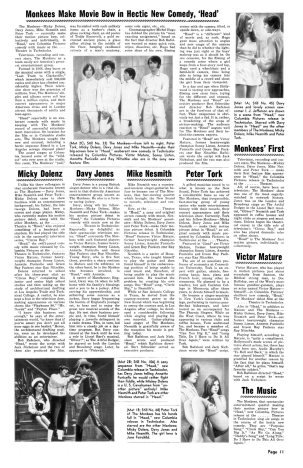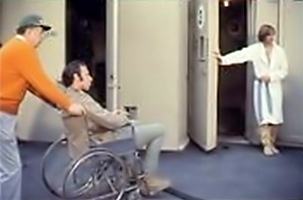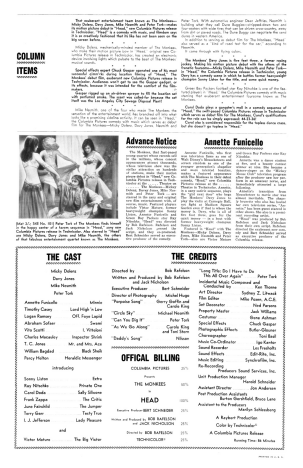|
EDIT NEWS: The Monkees - Head - Hype - Page 2
| |||||||||||||||||||||||||||||||||||||||||||||||||||||||||||||||||||||||||||||||||||||||||||||||||||||||||||||||||||||||||||||||||||||||||||||||||||||||||||||||||||||||||||||||||||||||||||||||||||||||||||||||||||||||||||||||||||||||||||||||||||||||||||||||||||||||
| Updated March 2013 | |||||||||||||||||||||||||||||||||||||||||||||||||||||||||||||||||||||||||||||||||||||||||||||||||||||||||||||||||||||||||||||||||||||||||||||||||||||||||||||||||||||||||||||||||||||||||||||||||||||||||||||||||||||||||||||||||||||||||||||||||||||||||||||||||||||||
| |||||||||||||||||||||||||||||||||||||||||||||||||||||||||||||||||||||||||||||||||||||||||||||||||||||||||||||||||||||||||||||||||||||||||||||||||||||||||||||||||||||||||||||||||||||||||||||||||||||||||||||||||||||||||||||||||||||||||||||||||||||||||||||||||||||||
Somewhere along the way it had evidently been decided that the Brockman 'Head' concept would be retained as part of the official press push - as 'Campaign A' ('For the "Modern" film audience!') - but that a secondary, far more 'traditional' approach would also be employed - 'Campaign B' ('For The Monkees' Fans!'). Page 9 of the original Head Pressbook spells it out for us in exciting, no-nonsense terms:
Fair enough, one might think. After all, if a studio has thrown a fair whack of money into realising a project (even a project which turned out as anti-commercial as Head) it might expect to see some return on that investment. And it certainly wasn't going get that by letting some New York hippie take the promotional reins completely, even if a fair whack of the promo-budget had already spent on filling his parking space. The two campaigns would run concurrently. To that end, the Columbia Pictures Pressbook contains two sets of print ads - one lot featuring paste-ups showcasing photos of the enigmatic Brockman face in various sizes, layouts and states of segmentation (with only occasional mentions of the Monkees' involvement); the other featuring a proper, newly-created Head poster design showing the band falling (or flying, whichever is your perception) through the air while a collage of disparate moments from the film cluttered the ground beneath them. Both campaigns however would share the same carefully-subbed newspaper quotes (mainly from reviews of the New York run) and both would offer up an array of accompanying 'audio-visual' accessories to bolster whichever campaign you decided to run with, including TV Spots, Radio Spots, Theatrical Trailers, Lobby Cards and a quite ridiculous amount of glossy press photos. Let's go through that Pressbook, page by page...
Depicts the following ad from 'Campaign B':
The collage for Ad No. 404 features:
Coca Cola machine. Micky) Liston The chosen review quotes are from Joseph Gelmis in Newsday: "a fun-movie that encompasses every other movie form - western, desert saga, war film, musical, horror film, science fiction! It's memorable!" ...and Renata Adler in the New York Times: "A movie for a turned-on audience!"
Amusingly, a newspaper ad from quite late in the initial New York run had used both the 'turned on' and 'smoking grass' comments within the same quote-block. The ad in question would later be rejigged slightly as a 'Campaign A' one-sheet, and use only the 'smoking grass' section (see Page 8, below). Of all the newspaper ads, this is the one which most resembles the official 'Campaign B' theatrical one-sheet in terms of collage layout and review quotes. The official list of co-stars comprise of 'Victor Mature and Sonny Liston and Annette Funicello and Carol Doda.' Despite their star-status, neither Mature nor Doda will be depicted visually as part of the ad/poster paste-ups (although Mature will feature on the Australian version of the poster). Rafelson, Nicholson and Schneider get good billing (although Raybert Productions aren't mentioned). A block caption also invites us to 'Hear The Monkees sing 'THE PORPOISE SONG' in the film and on the Colgems Soundtrack album.' An empty block at the base of the ad allows details of local cinema showings to be inserted.
Depicts the following ad from 'Campaign B':
The Dune-buggy, Arab army, and Peter/Swami/Sonny elements are also assembled differently (Peter, Swami and Sonny in particular appear to have been sliced into their component parts and bunched together more closely). Review quotes are from Elvera Herbstman in the New York Daily Column: "America is making great and meaningful movies! This is one of them!" ...and William Wolf in Cue Magazine: "An inventive, creative, first film for the Monkees!" Herbstman's quote had also graced the massive Head billboard on Sunset Strip. Sandoval reports that Wolf's very positive review was used (with the author's permission) as part of a newspaper ad for the film a few days before it was actually published in Cue Magazine. Co-star billing and production credits as per the ad on Page 1. Once again, space is left at the base for local cinema details.
Of all the ads, this is the one which most resembles the 'Campaign B' theatrical six-sheet and half-sheet in terms of collage layout and review quotes. The poster design however spaces the collage elements out in the middle, with a stretch of uncluttered desert.
Depicts the following ads from 'Campaign B':
Ad No. 306 reuses the Adler and Wolf quotes (the latter rejigged slightly).
The cutouts of the Monkees are bunched up closer on this layout, with Peter Tork overlapping Davy Jones slightly.
The co-star names are here given a somewhat hard-sell urgency with the underlining of the repeated use of the word 'and' throughout! Of all the newspaper ads, No. 306 is the one which most resembles the 'Campaign B' theatrical insert card in terms of collage layout and review quotes. Curiously, the tinted colouring of the Monkees clothing is completely different here when compared to the other colour posters. A caption for 'Utility Mat No. 1' namechecks the four line-art ads from this page, plus Ad No. 219 and Ad No. 228 (visually depicted on Pages 4 and 5 respectively), and 'Publicity 1B' and 'Publicity 2C'. Neither of these appear to be depicted in the Pressbook.
None of the ads on this page allow for local cinema details to be inserted.
Depicts the following ads from 'Campaign B':
Ad No. 210 is the same paste-up as Ad No. 306 on Page 3 but presented as two columns rather than three.
Ad No. 219 drops the base-collage completely and moves the 'urgent' co-star list above the layout of the falling Monkees. This is also the only ad on this page which includes a space for local cinema details (just barely).
Depicts the following ads from 'Campaign B':
Ad Nos. 220 and 228 again drop the base-collage and scatter the 'falling Monkees' cut-outs out to fill the column space. Ad No. 228 also drops all mention of the co stars. Wolf and Adler quotes used in these two ads respectively. Space for local cinema details in Ad Nos. 307 and 220 only.
To see a later version of Ad No. 228 in situ, as published in the Sumpter Daily Item, February 18 1969, click here. Note that by this time they'd added the somewhat desperate by-line 'A FUN Movie For The Entire Family!' and exclamation marks after the co-stars names.
Depicts the following ad from 'Campaign A':
A note underneath reads 'Also Available as Comparable Ad No. 301 - 366 Lines - 3 Cols. x 8⅞ Inches.' We shall of course explain what a 'comparable ad' is as soon as we've worked out what one is ourselves.
Considering the license with which the Renata Adler New York Times quote has been used so far, one must naturally assume that the description at the top of the page, "For The 'Turned On' Generation", actually means that this was a sanctioned campaign aimed at "people who smoke grass." This is where your hard-earned US cinema dollars were going, America. No wonder Nixon won that year.
Depicts the following ads from 'Campaign A':
"Refreshingly up to date, as if 8½ has been made by a flower-child!" Joe Rosen in the Morning Telegraph offers: "Funny, irreverent, colorful, fast-moving!" Joseph Gelmis' Newsday review quote, used for Ad No, 404 on Page 1, gets a (somewhat truncated) outing here, as do the thoughts of Bob Salmaggi from WINS Radio: "Bobs up as a heady hallucination, happy, hip and hairy!" Finally, another quote which will be much used in the ensuing campaign, from Ann Guarino of the New York Daily News: "A commentary on our times, spoofing politicians, movie-making and intellectuals!" No co-stars are mentioned in the ad, although both The Monkees and the 'Porpoise Song' get a mention (one of the few times during the 'Campaign A' print ads that this occurs). Local cinema detail space included.
No quotes had appeared on this version of the ad, with the middle strip segmenting Brockman's face given over to a complete cast list, and the header incorporating a list of celebrities expected to attend the event. A slight anomaly is that the 'Porpoise Song' caption block omits the word 'Colgems'. It's presumed therefore that the Pressbook was assembled after the Vogue Theatre premiere and that the omission was an oversight, later corrected (as we can't think of any feasible reason why a reference to Colgems would be actively removed). Ad No. 107 and Ad No. 222 set aside room for one short review quote each - from Bob Salmaggi and Elvera Herbstman respectively - but a myriad of optional alternate paste-in quotes are included. Mainly variations on those already covered in the Pressbook, but a couple of new ones - from Frances Taylor in the Long Island Press: "A film hit!" - and drama critic Martin Gottfried of WPAT, New Jersey:
"Important and refreshing!"
Depicts the following ads from 'Campaign A':
Each of the ads on this page are accompanied by one review quote each. Ad No. 311 favours the William Wolf write-up once again, with a longer version of the quote used in Ad No. 313: "In terms of sheer cinema, there is a mountain of creativity adding up to mod impressionism! HEAD is refreshingly up to date, as if 8½ has been made by a flower-child!" The credits manage to squeeze in a mention of The Monkees, although the block caption advertising the soundtrack album now omits specific reference to the 'Porpoise Song'. No space for local cinema details here. The remaining four ads re-use the Herbstman, Gelmis and Wolf review quotes - with no mention of the Monkees, the film-makers or even Columbia Pictures. There would have been no question that it was a film however, due to the wording of the chosen quotes (not to mention the Rating / MPAA logo and a space for local cinema details).
"'Head' is a film to see if you've been smoking grass!" Both The Monkees and the film-makers get a credit, and the 'Porpoise Song' refs are now back in the soundtrack LP caption block.
As mentioned earlier, the same basic design (and mostly the same quotes) had been used in a newspaper ad to publicise the New York run. However, the paste-up here was evidently redone from scratch as the photo of Brockman isn't the exact same one used in the original ad.
Explains the nature of the diverse campaigns (with promotional ideas) and a full list of 'Audio Visual Aids' available This page gives some inkling of why the 'two unique campaigns' plan was doomed to failure. It soon becomes painfully apparent that whoever masterminded it didn't really view the two projected audiences as particularly diverse entities - and simply cooked up the same kind of corny, half-baked promotional stunts and gameplans for both camps. Reading through the copy, it's hard not to picture some puffed-up ad executive desperately attempting to get to grips with the modern world and prove that he's totally 'hep' and 'with it, daddio' (while simultaneously dreaming up vaguely dubious ways of getting girls in mini-skirts involved). It's unlikely for instance that anyone did actually attempt to 'costume a local bally as a Guru' as part of 'Campaign A's 'GO GURU-ISH FOR 'HEAD'' idea (even if they happened to know what a 'bally' was - which we certainly don't). While certain aspects of the original John Brockman campaign are adhered to - particularly the slow-burn 'teaser' effect of displaying the enigmatic ads first and revealing those with credits towards the end - the accompanying refs to 'pretty girls' wearing makeshift Brockman sandwich boards; competitions for the best "Head"-style and promoting used cars painted with psychedelic designs render it all rather tacky and far more akin to 1950s frat-boy pranks than anything approaching 1960s mind-expanding 'counter-culture'. Not that the suggestions put forth for 'Campaign B's aim at the 'Monkees' fans' were any more well-targeted: 'Get local barbers to tie-in with posters in windows: "Your 'Head' is Our Business! See 'Head', etc" Hat stores can cooperate similarly.'Or not, as the case almost definitely was. With the core Monkees fanbase being young teenaged girls, the proposed radio contest asking people whose 'head' appears on various banknotes was hardly going to reach a target audience - and neither was the plan of planting press photos of the 'mod'-attired Monkees in 'Men's Fashion stores' (although the suggestion of doing the same in Sports stores with press pics of Victor Mature and Sonny Liston is probably even further off the mark). The less said about the I.J. Jefferson-referencing mini-skirt competition the better. Suffice to say that we're surprised the Pressbook made it to the printers without all its pages stuck together. Far more interesting, at least from a collector's standpoint, is the Audio-Visual Aids For Both Campaigns section. We can only speculate how the stuff mentioned in this block actually corresponds with the ads that are currently known. Page 3 of this article is given over to a far more detailed dissection of the various trailers and promo spots. A few things on the list should be itemised at this point though:
TELEVISION TRAILERS
RADIO SPOTS
THEATRE TRAILER ACCESSORIES For Both Campaigns
- 'Campaign B' posters of various sizes. The one sheet was 27" x 41" (portrait), the two-sheet was 41" x 81" (portrait), the six-sheet was 81" x 81" (landscape). As mentioned earlier, the latter used an alternate layout of the poster.
Currently unknown, but likely to be the 'Ditty Diego' trail.
14" x 36" - smaller version of the poster design. Can now be seen right here.
Half-sheet display printed on cardstock - a smaller version of the (landscape) poster design.
The full set of colour lobby cards. Currently on display here.
Currently unknown.
No idea
14" x 22"- most likely a small version of the (portrait) poster design.
Various displays, various sizes, all based on the (portrait) poster design.
Most likely the 24 x 82 title banner, which can now be seen right here.
We've never seen one of these but we're willing to bet it looks gorgeous.
And many of them. We've made a start at collecting them here.
As mentioned previously, the straight one-sheet for 'Campaign A' was a version of the posters plastered over the New York Subway and elsewhere during the initial week of cinema showings - albeit with no information aside from the Rating, MPAA logo and 'A Columbia Picture'.
Includes suggestions for promoting the film via the soundtrack LP, the Monkees' back-catalogue and a special interview disc. 'The Porpoise Song' had actually been released as a single a month prior to this campaign and hadn't made much of a dent on the charts - which probably accounts for the lack of references to it on this page, which seems more intent on selling the existing Monkees brand than their 'new direction'. An interesting reference there to the OST - released early November - already having been sent to college and underground radio stations. Quite how it would have been given 'a big "push" in juke boxes' isn't so clear since there was only one 7" release from the LP. The 'Half-Hour Interview Disc' would eventually become probably the rarest of all Monkees 'releases', with only a very small handful turning up on the collectors' market over the years. A straight vinyl dub has now been officially released as Disc 3 of Rhino Handmade's 'Deluxe Edition' of the soundtrack. The disc features Davy Jones waxing lyrically about the film (which at the time of the interview hadn't been completed - many of the scenes he enthusiastically describes in glowing terms ended up on the cutting room floor). At one point, Jones talks about what an honest portrayal of himself he's allowed in the film, adding that "there's stuff even my own father doesn't know about me". Sadly, Harry Jones would never get to see Head or hear this interview disc as he died on October 25 1968.
Originally available free from Dick Strout inc. Strout's dealings with Head also include a ten minute radio promo about the film which boasts exclusive interviews with Annette Funicello and Timothy Carey. Surface noise on the recording which does the rounds with collectors suggests a vinyl source so doubtless this was also available as a Columbia Pictures promo LP of some description at the time. You can hear it in full here.
Sadly, the Billboard online archive doesn't appear to have this particular edition available for viewing, but there are a couple of old photos from eBay on the right. Meanwhile, the LP itself was 'reviewed' in the December 7 1968 edition, alongside such classics as The Beatles' double-white album, The Rolling Stones' Beggars Banquet, Frank Zappa's Cruisin' With Ruben and the Jets and Leapy Lee's Little Arrows.
Includes pre-written news articles and notes on available stills. Some press-friendly notes on the making of the film, plus more general potted biographies of each of the Monkees and Victor Mature. Rather helpfully, both Dolenz and Jones' first names are mis-spelled several times - which would have saved the newspaper copywriters from having to do so themselves. The images used on Pages 11 and 12 appear to be either retouched or repainted versions of original photos, rendered for inclusion in the collage design for the 'Campaign B' one-sheet and newspaper ads (as we've seen, the slightly awkwardly-assembled Davy/Micky/Funicello from Page 11 and the Peter Tork/Harem from Page 12 made it to the collage). It's doubtful that they would have been offered in this form for use by newspapers and magazines - the Still nos. quoted most likely refer either to the original photos or a near equivalent. 'Still No. 68', featuring Peter Tork and June Fairchild, can be seen in action here, from a listings page in New York magazine on 18 November 1968 advertising the original run of the film. Despite being a press tool to encourage lazy journalists to write about (and therefore promote) the film, these pre-prepared news columns do throw up a few interesting nuggets of information not covered elsewhere.
For instance, cinematographer Michel Hugo's method of allowing the camera to mingle with and be part of the crowd during the June Fairchild suicide scene - by mounting it on a wheelchair. Suddenly, a previously-confusing production photo showing a wheelchair-bound Bob Rafelson overseeing the filming of that scene is explained: it's simply a case of the director checking to see how the shot will look through his own eyes before the camera starts rolling.
Includes more pre-written news columns and complete credits for the film The news columns are effectively mini-ads drawing attention to the film, partially disguised as insider gossip. As before however, these include a few interesting bits and pieces about the film not previously reported, including a nice reference to special effects man Chuck Gaspar creating a machine to get rid of the smell of shit on-set. The item about Micky Dolenz inventing 'an electronic device involving lights which pulsate to the beat of The Monkees' musical sounds' appears to be a garbled description of the 'Colortron,' a machine which flashed lights in response to all musical sounds, not just the Monkees (bass sounds lit up red lights, high-registers lit up blue, etc). Dolenz owned one of these around that time but certainly didn't invent it.
The writer of the item about Carol Doda sounds positively forlorn about her not appearing topless in Head. Ah well, from what we can see via Google Images, they were nothing to write home about anyway.
| |||||||||||||||||||||||||||||||||||||||||||||||||||||||||||||||||||||||||||||||||||||||||||||||||||||||||||||||||||||||||||||||||||||||||||||||||||||||||||||||||||||||||||||||||||||||||||||||||||||||||||||||||||||||||||||||||||||||||||||||||||||||||||||||||||||||
|
| |||||||||||||||||||||||||||||||||||||||||||||||||||||||||||||||||||||||||||||||||||||||||||||||||||||||||||||||||||||||||||||||||||||||||||||||||||||||||||||||||||||||||||||||||||||||||||||||||||||||||||||||||||||||||||||||||||||||||||||||||||||||||||||||||||||||
